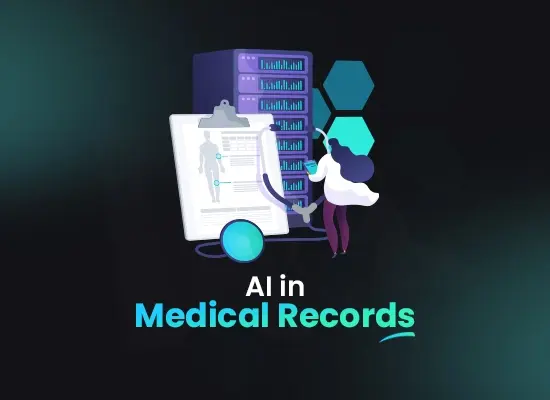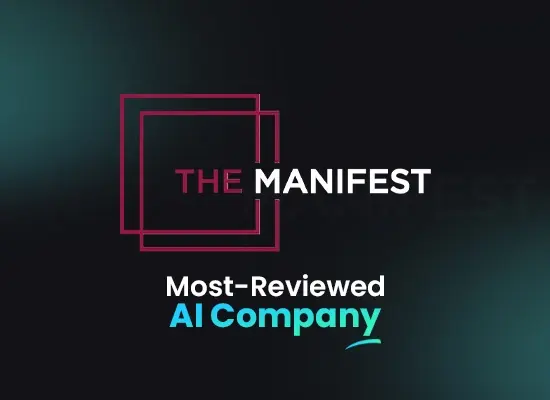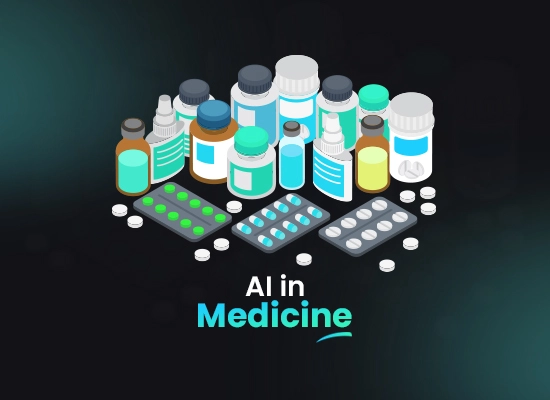AI in Remote Patient Monitoring – Enhancing Monitoring Systems in Healthcare
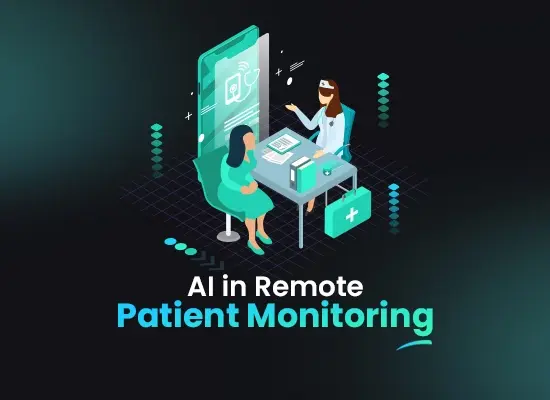
The rise of remote patient monitoring (RPM) is revolutionising healthcare by enabling doctors to track patients’ conditions remotely. Artificial intelligence (AI) is now supercharging RPM, allowing for continuous data analysis, early detection of health issues, and improved intervention strategies. This powerful combination is leading to better patient outcomes, reduced healthcare costs, and a more proactive approach to managing chronic conditions.
What is Remote Patient Monitoring?
Remote patient monitoring (RPM) is revolutionising the way healthcare software development manages patients, particularly those with chronic conditions. It utilises a patient monitoring system that gathers health data outside of the traditional clinical setting, empowering healthcare professionals to remotely track a patient’s condition. This allows for proactive care and intervention, potentially improving health outcomes and reducing overall healthcare costs.
At the core of RPM lies automated patient communication. Through wearable devices, mobile apps, and other digital tools, patients can easily transmit vital signs, blood sugar levels, or other relevant health data. This data is then securely transferred to a secure platform accessible by the healthcare provider. Automated monitoring tools can be implemented to analyse this data in real-time, flagging any readings that fall outside of normal ranges. This enables providers to identify potential health concerns early on, before they escalate into more serious problems.
The use of automation in healthcare through RPM goes beyond just data analytics. Automated alerts can be sent to both patients and providers, prompting necessary actions. For instance, a diabetic patient might receive an automated notification reminding them to take their medication if a blood sugar reading falls outside the recommended range. Similarly, a healthcare provider might be alerted if a patient’s blood pressure readings consistently exceed healthy limits, prompting a virtual consultation or an in-person visit.
Remote patient monitoring offers a multitude of benefits for both patients and providers. It empowers patients to take a more active role in managing their health, while allowing providers to extend their care beyond the confines of the clinic. This innovative approach to healthcare holds immense potential for the future, transforming the way we monitor and manage patient health remotely.
Seamless Collaboration | Cost-Efficient Solutions | Faster Time-to-Market

Why is Remote Patient Monitoring Important?
Remote patient monitoring (RPM) has emerged as a game-changer in healthcare, offering a plethora of benefits for both patients and providers. This innovative approach leverages technology to create a patient monitoring system that extends far beyond the walls of a clinic. By utilising wearable devices and other digital tools, RPM enables automated patient communication and automated monitoring of vital health data engineering services, even in the comfort of a patient’s home.
This shift towards remote patient monitoring is crucial for several reasons. Firstly, it empowers patients to take a more active role in managing their health. By having access to their own health data through user-friendly interfaces, patients can gain valuable insights into their condition. This can improve medication adherence and overall treatment effectiveness. Secondly, RPM allows for proactive care through automated monitoring. By constantly collecting health information, the system can identify concerning trends or potential complications early on. This enables healthcare providers to intervene swiftly, potentially preventing hospital admissions and improving patient outcomes.
Furthermore, automation in healthcare through remote patient monitoring systems frees up valuable time for medical professionals. Instead of spending hours on routine monitoring tasks, clinicians can focus on providing more personalised care and addressing complex patient needs. This not only enhances patient satisfaction but also allows healthcare providers to manage a larger patient base effectively. Additionally, RPM can significantly reduce costs associated with traditional in-person monitoring. By minimising unnecessary hospital visits and readmissions, remote patient monitoring programs can contribute to a more sustainable healthcare system.
In conclusion, the importance of remote patient monitoring cannot be overstated. This technology offers a win-win situation for both patients and providers, promoting better health outcomes, increased patient engagement, improved efficiency, and cost savings within the healthcare system. With continuous advancements in automation in healthcare, remote patient monitoring systems are poised to play an even more significant role in shaping the future of healthcare delivery.
How to use Automated Patient Communication to your Benefit?
The healthcare industry is experiencing a surge in automation in healthcare, and automated patient communication is at the forefront of this transformation. By leveraging automated communication tools, medical practices can streamline workflows, improve patient engagement, and ultimately deliver better care. Here are seven key ways automated patient communication can benefit your practice:
1- Enhanced Appointment Management:
Imagine a system that automatically sends appointment reminders and confirmations via text message or email. This not only frees up staff time typically spent on phone calls, but also reduces the chances of missed appointments. Automated communication can even allow patients to confirm or reschedule appointments directly through the message, further enhancing convenience.
2- Streamlined Refill Process:
Automated communication can be a game-changer for managing prescription refills. Automated monitoring of medication levels within a patient monitoring system can trigger alerts when a refill is needed. The system can then send an automated notification to the patient prompting them to request a refill online or through the practice’s app. This not only saves patients time and improves medication adherence, but also frees up staff to focus on other tasks.
3- Improved Remote Patient Monitoring:
The rise of remote patient monitoring allows healthcare providers to track a patient’s health data remotely. Automated communication plays a crucial role here. Automated monitoring systems can analyze patient-generated data and send alerts to healthcare providers if readings fall outside normal ranges. This enables timely intervention and potentially prevents complications. The system can also send automated messages to patients with personalised health tips or reminders to take vital sign readings.
4- Personalized Patient Education:
Automated communication can be a powerful tool for patient education. Following appointments, patients can receive automated messages with personalised information about their condition, medication instructions, or healthy lifestyle tips. This not only reinforces what was discussed during the visit, but also empowers patients to take an active role in their health management.
5- Increased Patient Satisfaction:
By improving efficiency and communication, automated patient communication can significantly enhance the patient experience. Patients appreciate timely appointment reminders, refill notifications, and clear post-visit instructions. This translates to increased patient satisfaction and loyalty.
6- Reduced Administrative Costs:
Automating routine tasks such as appointment reminders and prescription refills frees up staff time, allowing them to focus on more complex tasks. This not only improves overall practice efficiency, but also reduces administrative costs.
7- Improved Revenue Cycle Management:
Automated communication can play a role in improving revenue cycle management. For instance, automated appointment reminders can help reduce no-shows, which can have a significant financial impact on a practice. Additionally, automated billing reminders can help ensure timely payments from patients.
By implementing automated patient communication strategies, healthcare providers can experience a wide range of benefits, from improved patient care to increased practice efficiency. It’s a win-win situation for both patients and providers.
13 Ways Automation in Healthcare can be Beneficial:
The healthcare industry is undergoing a significant transformation driven by automation technologies. This revolution is bringing a wave of benefits for both patients and medical professionals. Here are 13 key ways automation in healthcare can be instrumental:
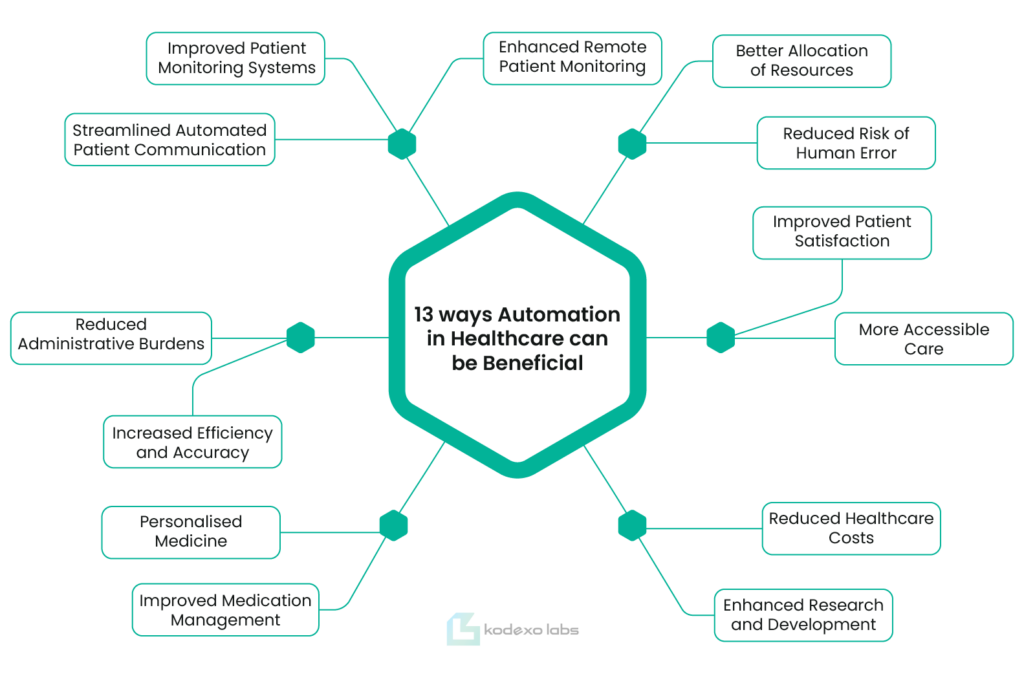
1- Enhanced Remote Patient Monitoring:
Automation empowers healthcare by enabling real-time data collection through wearable devices and sensors. These systems can track vital signs, blood sugar levels, or activity levels, allowing healthcare providers to monitor patients remotely and intervene promptly if necessary.
2- Improved Patient Monitoring Systems:
Automated patient monitoring systems can continuously gather and analyse patient data in hospitals or clinics. This allows for quicker detection of changes in a patient’s condition, potentially leading to more timely treatment and improved outcomes.
3- Streamlined Automated Patient Communication:
Automation can streamline communication between patients and healthcare providers. Automated appointment reminders, medication refill prompts, and post-discharge follow-up messages can ensure patients stay on track with their care plans.
4- Reduced Administrative Burdens:
Repetitive administrative tasks like scheduling appointments, processing insurance claims, and generating reports can be automated, freeing up valuable time for doctors and nurses to focus on patient care.
5- Increased Efficiency and Accuracy:
Automation can significantly improve efficiency in healthcare settings. Automated tasks are often completed faster and with fewer errors compared to manual processes.
6- Personalised Medicine:
LLMs can automate repetitive tasks such as data entry, document summarization, and report generation. This frees up employee time to focus on more strategic initiatives.
7- Improved Medication Management:
Automated medication dispensing systems can ensure patients receive the correct dosages at the right times, reducing the risk of medication errors.
8- Enhanced Research and Development:
Automation can play a crucial role in healthcare research by accelerating data analysis and facilitating clinical trials.
9- Reduced Healthcare Costs:
By improving efficiency and reducing errors, automation can lead to significant cost savings in the healthcare system.
10- More Accessible Care:
Telemedicine platforms powered by automation can expand access to healthcare for patients in remote areas or with limited mobility.
11- Improved Patient Satisfaction:
Automation can contribute to a more positive patient experience by reducing wait times, improving communication, and ensuring timely care.
12- Reduced Risk of Human Error:
Automating repetitive tasks can minimise the risk of human error, leading to safer and more effective patient care.
13- Better Allocation of Resources:
By freeing up staff time from administrative tasks, automation allows healthcare providers to focus on more complex patient needs, leading to a better allocation of resources.
The potential of automation in healthcare is vast. As technology continues to evolve, we can expect even more innovative ways to leverage automation to improve patient care, reduce costs, and create a more efficient healthcare system.
Automated Monitoring in Healthcare:
The healthcare industry is undergoing a significant transformation with the integration of automation technologies. One of the most impactful areas is automated monitoring, which encompasses a range of tools and systems designed to continuously track a patient’s health status. This can occur in both hospital settings and remotely, fundamentally changing the way we deliver care.
At the core of automated monitoring lies the concept of patient monitoring systems. These systems utilise various sensors and devices to collect real-time data on vital signs like heart rate, blood pressure, and oxygen levels. This data is then transmitted wirelessly to a centralised hub or cloud platform, allowing for continuous monitoring and analysis. This paves the way for healthcare, where patients can be monitored from the comfort of their homes, reducing hospital readmission rates and improving overall care management.
Automated patient communication is another key aspect of automated monitoring. By leveraging collected data and pre-programmed protocols, these systems can send automated alerts and reminders to both patients and healthcare providers. For instance, if a patient’s vital signs deviate from pre-set thresholds, an automated alert can be sent to the healthcare team, prompting them to intervene if necessary. This not only frees up valuable time for clinicians but also empowers patients to take a more active role in managing their health.
The benefits of automation in healthcare extend far beyond just remote patient monitoring and automated communication. Automated monitoring systems can analyse vast amounts of patient data, identifying trends and potential health risks. This allows for early detection and intervention, potentially leading to improved patient outcomes and reduced healthcare costs. As automation continues to evolve, we can expect even more sophisticated patient monitoring systems to emerge, further revolutionising the way we deliver and manage healthcare.
A Deep Dive into Algorithms used for Automated Patient Communication:
The rise of artificial intelligence (AI) has brought significant changes to the healthcare landscape, and automated patient communication is one area witnessing this transformation. Algorithms are playing an increasingly important role in facilitating communication between patients and healthcare providers.
These algorithms power various tools and functionalities. One key application is through AI chatbot development, which can answer basic patient queries, schedule appointments, and even triage symptoms. They can also provide educational resources and reminders about medication adherence.
Beyond chatbots, algorithms are used in healthcare systems. Here, they analyse data collected from wearable devices or patient-reported information to identify trends and potential health risks. If an algorithm detects an anomaly, it can trigger automated messages reminding patients to take action or prompting them to contact a healthcare professional.
The use of algorithms in patient communication holds immense potential for improving healthcare delivery. By automating routine tasks and providing timely information, these algorithms can free up valuable time for doctors and nurses, allowing them to focus on more complex patient needs. Additionally, they can improve patient engagement by providing convenient access to information and support, ultimately leading to better health outcomes.
7 Ways AI in Remote Patient Monitoring Can Save Lives:
Remote patient monitoring (RPM) has revolutionised healthcare by allowing medical professionals to track a patient’s health data from a distance. This data can include vital signs, activity levels, and even medication adherence. However, the sheer volume of data collected can be overwhelming for doctors to analyse effectively. This is where artificial intelligence (AI) steps in. AI algorithms can sift through mountains of patient data, identifying trends and potential issues that human eyes might miss. Here are seven ways AI in remote patient monitoring can have a life-saving impact:
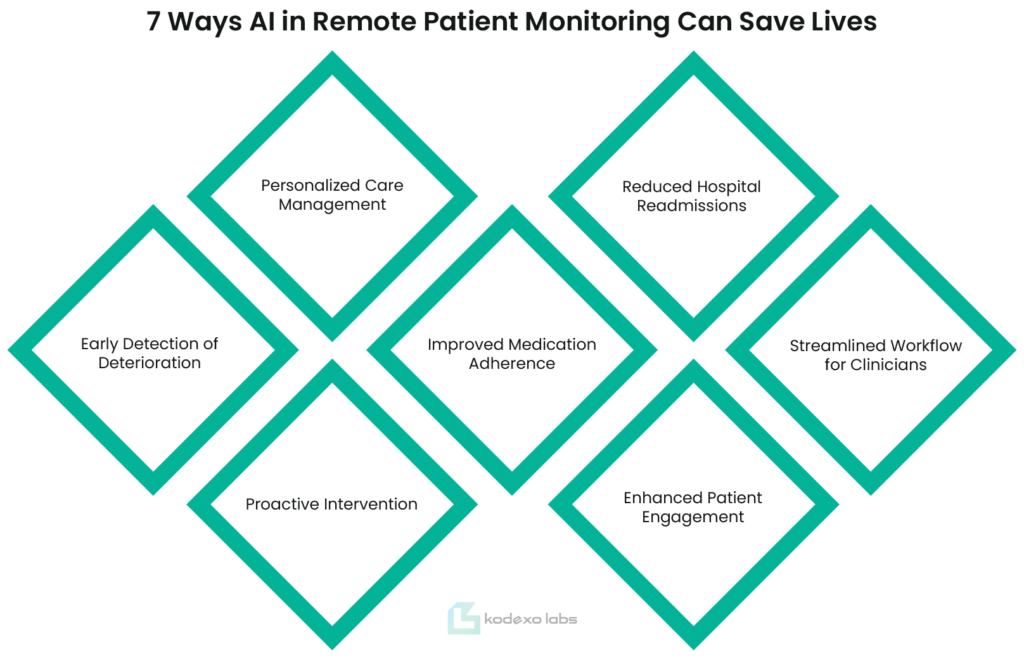
1- Early Detection of Deterioration:
AI can continuously analyse vital signs and identify subtle changes that could indicate a developing health crisis. This allows for earlier intervention, potentially preventing a minor issue from escalating into a life-threatening emergency.
2- Personalized Care Management:
AI can help personalise treatment plans by taking into account a patient’s unique medical history, lifestyle habits, and real-time health data. This allows for more targeted interventions and adjustments as needed.
3- Proactive Intervention:
AI can predict potential health problems based on patient data and trends. This allows for preventive measures to be taken before a patient’s condition worsens, potentially avoiding hospital admissions altogether.
4- Improved Medication Adherence:
AI-powered monitoring systems can track medication use and remind patients to take their medication as prescribed. This can be particularly crucial for patients managing chronic conditions where consistent medication use is critical.
5- Reduced Hospital Readmissions:
By enabling closer monitoring and earlier intervention, AI in RPM can help prevent complications that might otherwise lead to hospital readmission. This translates to better patient outcomes and lower healthcare costs.
6- Enhanced Patient Engagement:
AI-powered RPM systems can provide patients with real-time feedback on their health status and progress towards treatment goals. This empowers patients to take a more active role in managing their own health.
7- Streamlined Workflow for Clinicians:
AI can automate routine tasks like data analysis and generating reports, freeing up valuable time for clinicians to focus on providing direct patient care. This can lead to improved patient satisfaction and better overall healthcare delivery.
In conclusion, AI is rapidly transforming healthcare, offering the potential to save lives through early detection, personalised care, and proactive intervention. As AI technology continues to develop, its impact on healthcare and overall healthcare is poised to grow even stronger.
Seamless Collaboration | Cost-Efficient Solutions | Faster Time-to-Market

10 Ways Kodexo Labs help you in getting a Remote Patient Monitoring Software?
In today’s healthcare landscape, remote patient monitoring (RPM) software is becoming increasingly important. It allows healthcare providers to track and manage patients’ health data remotely, improving patient outcomes and reducing healthcare costs. But developing RPM software can be a complex task. This is where Kodexo Labs, an AI software development company comes in. Here are 10 ways Kodexo Labs can assist you in acquiring RPM software:

1- Expertise and Experience:
Kodexo Labs boasts a team of experts with extensive experience in designing, developing, and deploying RPM software solutions. Their knowledge of healthcare workflows and technical capabilities ensures they can create software that meets your specific needs and complies with industry regulations.
2- Needs Assessment and Planning:
They will work closely with you to understand your requirements, the patient population you cater to, and the functionalities you envision in your RPM software. This collaborative approach ensures the final product aligns perfectly with your goals.
3- Customizable Solutions:
Kodexo Labs understands that a one-size-fits-all solution doesn’t work in healthcare. They offer custom product development, allowing you to tailor features and functionalities to your specific needs and patient demographics.
4- Data Security and Privacy:
With patient data privacy being paramount, Kodexo Labs prioritises robust security measures in their RPM software. They ensure your platform adheres to HIPAA and other relevant data privacy regulations.
5- Integration with Existing Systems:
Their expertise allows them to integrate your RPM software seamlessly with your existing electronic health record (EHR) and other healthcare IT systems. This streamlines data flow and improves workflow efficiency.
6- Scalability and Future-Proofing:
Keeping in mind the evolving healthcare landscape, Kodexo Labs designs scalable RPM software solutions. Their platform can adapt to accommodate growth in your patient base and integrate with new technologies as they emerge.
7- User-Friendly Interface:
They understand that user adoption is crucial for the success of any software. They design intuitive and user-friendly interfaces for both healthcare providers and patients, ensuring ease of use and maximising the software’s potential.
8- Ongoing Support and Maintenance:
Kodexo Labs doesn’t just build software; they provide ongoing support and maintenance services. Their team will be there to address any issues, troubleshoot problems, and ensure your RPM software functions optimally.
9- Cost-Effectiveness:
Developing RPM software in-house can be expensive. Kodexo Labs offers cost-effective solutions, ensuring you get the most value for your investment.
10- Faster Time-to-Market:
Their development expertise allows them to deliver high-quality RPM software solutions within a reasonable timeframe. This enables you to leverage the benefits of RPM technology sooner rather than later.
By partnering with Kodexo Labs, you gain access to a team of experts who can guide you through the entire process of acquiring RPM software, from initial planning to deployment and ongoing support. This ensures a smooth and successful implementation, allowing you to reap the numerous benefits of RPM technology.

Author Bio
Syed Ali Hasan Shah, a content writer at Kodexo Labs with knowledge of data science, cloud computing, AI, machine learning, and cyber security. In an effort to increase awareness of AI’s potential, his engrossing and educational content clarifies technical challenges for a variety of audiences, especially business owners.
